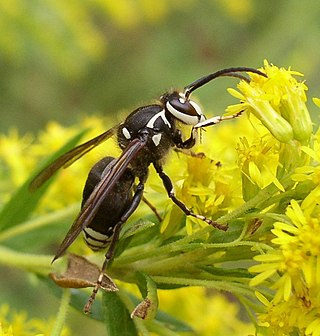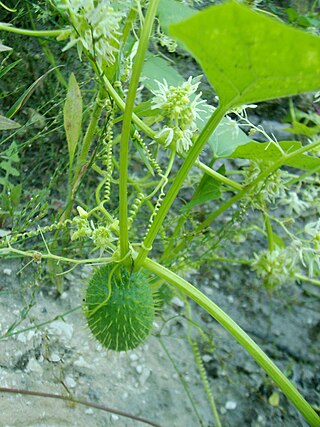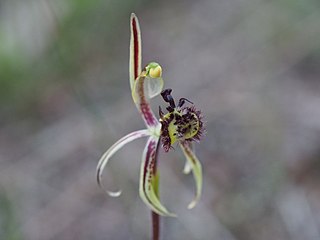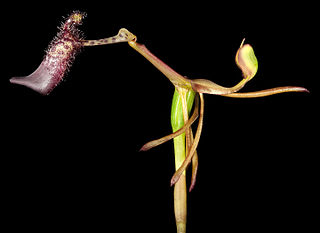
Vespoidea is a superfamily of wasps in the order Hymenoptera. Vespoidea includes wasps with a large variety of lifestyles including eusocial, social, and solitary habits, predators, scavengers, parasitoids, and some herbivores.

The blue ant, also known as the blue-ant or bluebottle, is a species of flower wasp in the family Thynnidae. It is the sole member of the genus Diamma and of the subfamily Diamminae. Despite its common name and wingless body, it is not an ant but rather a species of large, solitary, parasitic wasp.

Caladenia, commonly known as spider orchids, is a genus of 350 species of plants in the orchid family, Orchidaceae. Spider orchids are terrestrial herbs with a single hairy leaf and a hairy stem. The labellum is fringed or toothed in most species and there are small projections called calli on the labellum. The flowers have adaptations to attract particular species of insects for pollination. The genus is divided into three groups on the basis of flower shape, broadly, spider orchids, zebra orchids and cowslip orchids, although other common names are often used. Although they occur in other countries, most are Australian and 136 species occur in Western Australia, making it the most species-rich orchid genus in that state.

Drakaea is a genus of 10 species in the plant family Orchidaceae commonly known as hammer orchids. All ten species only occur in the south-west of Western Australia. Hammer orchids are characterised by an insectoid labellum that is attached to a narrow, hinged stem, which holds it aloft. The stem can only hinge backwards, where the broadly winged column carries the pollen and stigma. Each species of hammer orchid is pollinated by a specific species of thynnid wasp. Thynnid wasps are unusual in that the female is flightless and mating occurs when the male carries a female away to a source of food. The labellum of the orchid resembles a female thynnid wasp in shape, colour and scent. Insect pollination involving sexual attraction is common in orchids but the interaction between the male thynnid wasp and the hammer orchid is unique in that it involves the insect trying to fly away with a part of the flower.

Echinocystis is a monotypic genus in the gourd family, Cucurbitaceae. The sole species is E. lobata, commonly called wild cucumber, prickly cucumber or bur cucumber. It is an annual, sprawling plant that is native to North America.

Arthrochilus, commonly called elbow orchids, is a genus of about fifteen species of flowering plants from the orchid family (Orchidaceae) and is found in Australia and New Guinea. The flowers are pollinated by male thynnid wasps which attempt to mate with the flower and are held in place by hooks while the pollinium is transferred between insect and flower.

Caladenia barbarossa, commonly known as the common dragon orchid, is a species of orchid endemic to the south-west of Western Australia. It can be distinguished by its distinctive labellum which is attractive to species of male thynnid wasps.
Drakaea concolor, commonly known as the kneeling hammer orchid, is a species of orchid endemic to the south–west of Western Australia. The species is only known from a few areas in the far west of the state and has been declared "vulnerable" by the Australian Government and "threatened" by the Government of Western Australia.
Drakaea confluens, commonly known as late hammer orchid is a species of orchid endemic to the south–west of Western Australia. It is similar to other hammer orchids in that it is pollinated by a single species of male thynnid wasp using sexual deception. The orchid's labellum is similar in shape and scent to a specific species of flightless female thynnid wasp. The species was discovered and collected in 1930 but was not formally described until 2007. It is only known from three areas in the south of the state and has been declared "endangered" by the Australian government and "threatened" by the Government of Western Australia.

Drakaea glyptodon, commonly known as king in his carriage is a species of orchid endemic to the south–west of Western Australia. It is pollinated by a single species of male thynnid wasp using sexual deception. The orchid's labellum is similar in shape and scent to a flightless female thynnid wasp. It is the most common drakaea and has the widest distribution.

Drakaea gracilis, commonly known as slender hammer orchid, is a species of orchid endemic to the south–west of Western Australia. It is pollinated by a single species of male thynnid wasp using sexual deception. The orchid's labellum is similar in shape and scent to a flightless female thynnid wasp. It was first collected in 1900 but other names were given to it, including Drakaea elastica and D. fitzgeraldii. It was not until 2007 when studies of the drakaeas and their pollinators were carried out, that the present species was recognised as distinct.

Drakaea livida, commonly known as warty hammer orchid, is a species of orchid endemic to the south–west of Western Australia. It is pollinated by a single species of male thynnid wasp using sexual deception. The orchid's labellum is similar in shape and scent to a flightless female thynnid wasp. Although the species was formally described in 1842, the description was often later overlooked and other hammer orchids were given the name Drakea livida. It is now known to be, along with Drakaea glyptodon, one of the most widespread of the genus.
Drakaea micrantha, commonly known as the dwarf hammer orchid is a species of orchid endemic to the south–west of Western Australia. It is similar to other hammer orchids in that it is pollinated by a single species of male thynnid wasp using sexual deception. The orchid's labellum is similar in shape and scent to a flightless female thynnid wasp. It has a single silvery-grey, heart-shaped leaf with prominent green veins and a stem up to 30 centimetres (12 in) long. The species is only known from a scattered populations in the south west of the state and has been declared "vulnerable" by the Australian government and "threatened" by the government of Western Australia.

Drakaea thynniphila, commonly known as narrow-lipped hammer orchid is a species of orchid endemic to the south–west of Western Australia. It is pollinated by a single species of male thynnid wasp using sexual deception. The orchid's labellum is similar in shape and scent to a flightless female thynnid wasp. It is one of the more common drakaeas and is easily distinguished from the other species. The tiny lumps on its leaf along with the long flower that lacks a swollen labellum are diagnostic.

Arthrochilus latipes, commonly known as robust elbow orchid, is a flowering plant in the orchid family (Orchidaceae) and is endemic to the "Top End" of the Northern Territory in Australia. Each plant has from two to four ground-hugging leaves and between three and fifteen flowers during the wet season and the species often forms spreading colonies on sandstone escarpments. Like others in the genus, the flowers are pollinated by a species of thynnid wasp.

The Thynnidae are a family of large, solitary wasps whose larvae are almost universally parasitoids of various beetle larvae, especially those in the superfamily Scarabaeoidea. Until recently, the constituents of this family were classified in the family Tiphiidae, but multiple studies have independently confirmed that thynnids are a separate lineage.

Myzinum maculatum is a species of wasp in the family Thynnidae. It is used as a biological control of turf grass pests.

Myzinum is a genus of wasps in the family Thynnidae. There are 63 species presently recognized in Myzinum. They measure 7–24 mm. They are found in meadows, fields, and lawns. They parasitize white grubs, including Phyllophaga. They are used as biological controls.

Thynnoidea is a superfamily of hymenopterans in the order Hymenoptera. There are 2 families and hundreds of described species in Thynnoidea.

Myzinum obscurum is a species of wasp in the family Thynnidae. It is found in the Eastern United States.

















